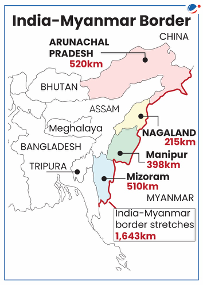Why in the News?
Union Ministry of Home Affairs has decided to scrap Free Movement Regime (FMR) between India and Myanmar.
More on News
- Move is aimed to ensure internal security of the country and maintain demographic structure of India’s North-eastern States bordering Myanmar.
- Government has also decided to fence the Indo-Myanmar border. Currently, border with Myanmar (approx. 1643 km) is predominantly unfenced, except for a small section in Manipur covering approximately 10 km.

FMR between India and Myanmar
- It permits individuals residing within a 16 km radius of the border to traverse freely, without requirements of a visa or other documentation.
- It was formalized in 2018 as part of India’s Act East Policy.
- FMR regime conceptualized due to following reasons
- Strong ethnic and familial ties across the border: The border demarcated by the British in 1826 effectively divided people of the same ethnicity and culture into two nations without their consent.
- Local trade and business: The region has a long history of trans-border commerce through customs and border haats. Given the low-income economy, such exchanges are vital for the sustenance of local livelihoods.
Reasons for Scrapping FMR
- Illegal immigration: Uncontrolled immigration of Chin people from Myanmar leading to demographic changes in the region.
- Ethnic violence and insurgency: Meitei community attributed last year’s tensions to the perceived illegal migration of tribal Kuki-Chin communities.
- Entry of soldiers from Myanmar: Exodus of junta soldiers seeking sanctuary in Mizoram which has serious security implications in India’s northeast.
- Surge in narcotics production in Myanmar: A report by UN Office on Drugs and Crime (UNODC) linked Myanmar’s political turmoil under military junta to surge in flow of narcotics in the region.
Other aspects of India-Myanmar relations
|
Way Forward
- Border management: Union and the state governments as well as the border residents ensure that the border between India- and Myanmar is effectively secured and regulated.
- Strengthen security of the border by either giving the Assam Rifles the single mandate of guarding the border or deploying another border guarding force on Indo - Myanmar border.
- Expedite construction of Integrated Check Posts (ICPs) along with other infrastructure.
- Diplomatic: There is a need of diplomatic agility in India’s engagement with Myanmar, including with military junta, to promote and protect national and regional interests.
- Weigh in the impact of action taken vis-à-vis corresponding benefits accrued in the context of regional security and India’s ‘Act East’ policy initiatives.
- Community engagement: Involve tribal communities in decision making to address sensitive issues and tribal fault lines as was visible in last year’s Manipur violence.



